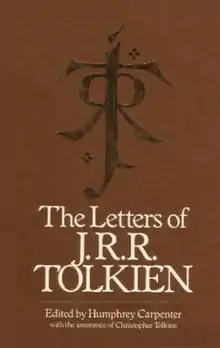The Letters of J. R. R. Tolkien
The Letters of J. R. R. Tolkien is a selection of J. R. R. Tolkien's letters published in 1981, edited by Tolkien's biographer Humphrey Carpenter assisted by Christopher Tolkien. The selection from a large mass of materials contains 354 letters, dating between October 1914, when Tolkien was an undergraduate at Oxford, and 29 August 1973, four days before his death. The letters are of interest both for what they show of Tolkien's life and for his interpretations of his Middle-earth writings.
 Dust wrapper of UK first edition | |
| Author | Humphrey Carpenter (editor), with Christopher Tolkien |
|---|---|
| Country | United Kingdom |
| Language | English |
| Subject | J. R. R. Tolkien War Tolkien's legendarium |
| Genre | Letters |
| Publisher | George Allen & Unwin, Houghton Mifflin |
Publication date | 1981 |
| ISBN | 0-04-826005-3 |
| OCLC | 8628512 |
| 828/.91209 B 19 | |
| LC Class | PR6039.O32 Z48 1981b |
| Preceded by | Unfinished Tales |
| Followed by | Mr. Bliss |
Contents
The book has a 3-page introduction by its editor, Humphrey Carpenter. It notes that an "enormous quantity of material [had] to be omitted, and that only passages of particular interest could be included." The omissions include "the very large body of letters" written between 1913 and 1918 to Edith Bratt, the woman who became his wife. Carpenter notes that few letters from the period between 1918 and 1937 survive, and those "unfortunately" say nothing about the writing of The Silmarillion or of The Hobbit.[1]
The body of the book consists of extracts from 354 of J. R. R. Tolkien's many letters. The first, dated October 1914, is to Bratt, when Tolkien was an undergraduate at Oxford. The last, dated 29 August 1973, is to Priscilla Tolkien, his youngest child, four days before his death.
The letters are accompanied by detailed notes, and by an index compiled by the Tolkien scholars Christina Scull and Wayne G. Hammond.
The letters can be roughly divided in four categories:
- Personal letters to Tolkien's wife Edith, his son Christopher Tolkien, and his other children
- Letters about Tolkien's career as a professor of Anglo-Saxon
- Letters to his publishers at Allen & Unwin
- Letters about Tolkien's Middle-earth writings
Letters 29 and 30 show that a German translation of The Hobbit was being negotiated in 1938. The German firm enquired whether Tolkien was of Arisch (Aryan) origin. Tolkien was infuriated by the racist implications of this, and wrote two drafts of possible replies for his publisher to choose.[2]
Having fought in the First World War, Tolkien wrote many letters during the Second World War to his son Christopher, including his reaction to the atomic bombing of Hiroshima, in which he calls the bombmakers of the Manhattan Project "lunatic" and "Babel builders".[3]
I have what some might call an Atlantis complex. Possibly inherited, though my parents died too young for me to know such things about them, and too young to transfer such things by words. Inherited from me (I suppose) by one only of my children, though I did not know that about my son until recently, and he did not know it about me. I mean the terrible recurrent dream (beginning with memory) of the Great Wave, towering up, and coming in ineluctably over the trees and green fields. (I bequeathed it to Faramir.) I don't think I have had it since I wrote the "Downfall of Númenor" as the last of the legends of the First and Second Age.
Letters, #163 to W. H. Auden, 7 June 1955
In 1951, Tolkien hoped that Collins would publish both The Lord of the Rings and The Silmarillion. To help persuade them that the two were "interdependent and indivisible",[4] he sent a letter (#131) to Milton Waldman of Collins, outlining the foundations and ambitions of his writings, and giving a potted history of the whole story from the creation, through the First, Second and Third Ages, and finishing with a reference to The Hobbit and a lengthy outline of The Lord of the Rings.[lower-alpha 1] The Tolkien scholar Colin Duriez describes the 10,000-word letter as "one of the best keys to the extraordinary legendarium".[6]
Other letters discuss subjects as widely varied as the location of Middle-earth ("the actual Old World of this planet", p.220, #165), the shape of hobbits' ears ("only slightly pointed", #27) and the source of the "Downfall of Númenor" in Tolkien's recurring dream of Atlantis (#163).[7]
Publication history
The book was published in 1981 by Allen & Unwin in London.[8] They reprinted it in 1990, 1995, and (having been taken over by HarperCollins) 2006.[9] Houghton Mifflin published a paperback edition in Boston in 2000.[10]
Reception
Hannu Hiilos, reviewing the book, notes that the letters it contains had been chosen from "a very large volume of material". He comments that Humphrey Carpenter and Christopher Tolkien had attempted both to prioritise Tolkien's accounts of his Middle-earth writings, and to give a picture of the breadth of Tolkien's other interests and scholarship. In addition, he writes, Tolkien's views, coloured by his position on religion, morals, and politics, come across clearly in his wartime letters to Christopher.[11] The Tolkien scholar Douglas A. Anderson states that Carpenter "quietly withdrew from Tolkien scholarship" soon after publishing the Letters. Anderson states that he assisted Carpenter on Letters, "particularly with the headnotes and the annotations".[12] The scholar of religion Peter Kreeft comments that the letters are important as all Tolkien scholars have to start by noting their interpretations of Tolkien's writings, unless they "dare to assume" they know better than Tolkien did what he may have meant.[13]
Notes
- The lengthy outline, omitted from the book, has been published in The Lord of the Rings: A Reader's Companion.[5]
References
- Carpenter 1981, Introduction.
- Tolkien, J. R. R.; Carpenter, Humphrey; Tolkien, Christopher (2014). The Letters of J. R. R. Tolkien. Boston: Houghton Mifflin. Editorial comments at the head of Letter 30. ISBN 978-0-61805-6-996.
- Carpenter 1981, #102 to Christopher Tolkien, 9 August 1945.
- Carpenter, Humphrey (1977). J. R. R. Tolkien: A Biography. New York: Ballantine Books. ISBN 978-0-04-928037-3.
- Hammond, Wayne G.; Scull, Christina (2005). The Lord of the Rings: A Reader's Companion. London: HarperCollins. p. 742. ISBN 0-00-720907-X.
- Duriez, Colin (2012). J.R.R. Tolkien: The Making of a Legend. Oxford: Lion Books. p. 201. ISBN 978-0-7459-5514-8.
- Patterson, Nancy-Lou (15 April 1982). "Reviews". Mythlore. 9 (1): 27–28.
- Carpenter, Humphrey, ed. (1981). The Letters of J. R. R. Tolkien. Boston: Houghton Mifflin. ISBN 978-0-395-31555-2.
- Carpenter, Humphrey; Tolkien, Christopher (2006). The Letters of J. R. R. Tolkien. Boston: Houghton Mifflin.
- Carpenter, Humphrey; Tolkien, Christopher (2006). The Letters of J. R. R. Tolkien. London: Allen & Unwin.
- Hiilos, Hannu (1990). ""Letters of J. R. R. Tolkien" edited by Humphrey Carpenter (Book Review)". Foundation (Summer 1990): 90.
- Anderson, Douglas A. (2005). "Obituary: Humphrey Carpenter (1946-2005)". Tolkien Studies. 2 (1): 217–224. doi:10.1353/tks.2005.0004. S2CID 170396849.
- Kreeft, Peter (1982). "Book Review: The Letters of J.R.R. Tolkien". Christianity & Literature. 31 (4): 107–109. doi:10.1177/014833318203100434.
Sources
- Carpenter, Humphrey, ed. (1981). The Letters of J. R. R. Tolkien. Boston: Houghton Mifflin. ISBN 978-0-395-31555-2.
